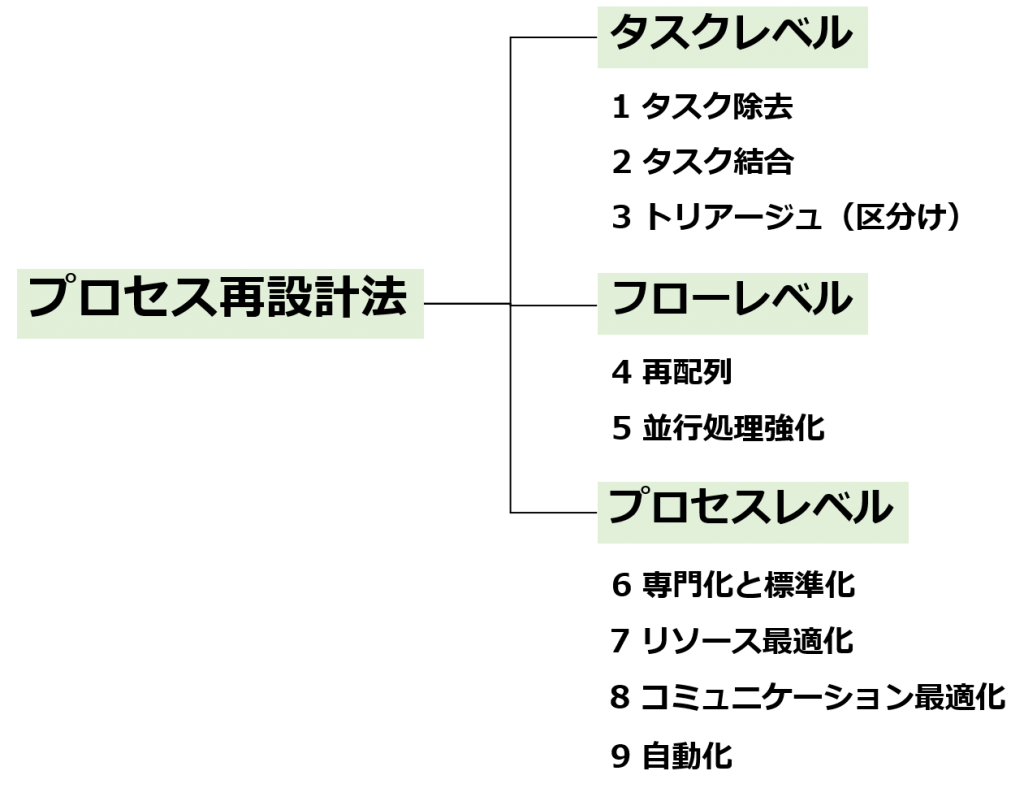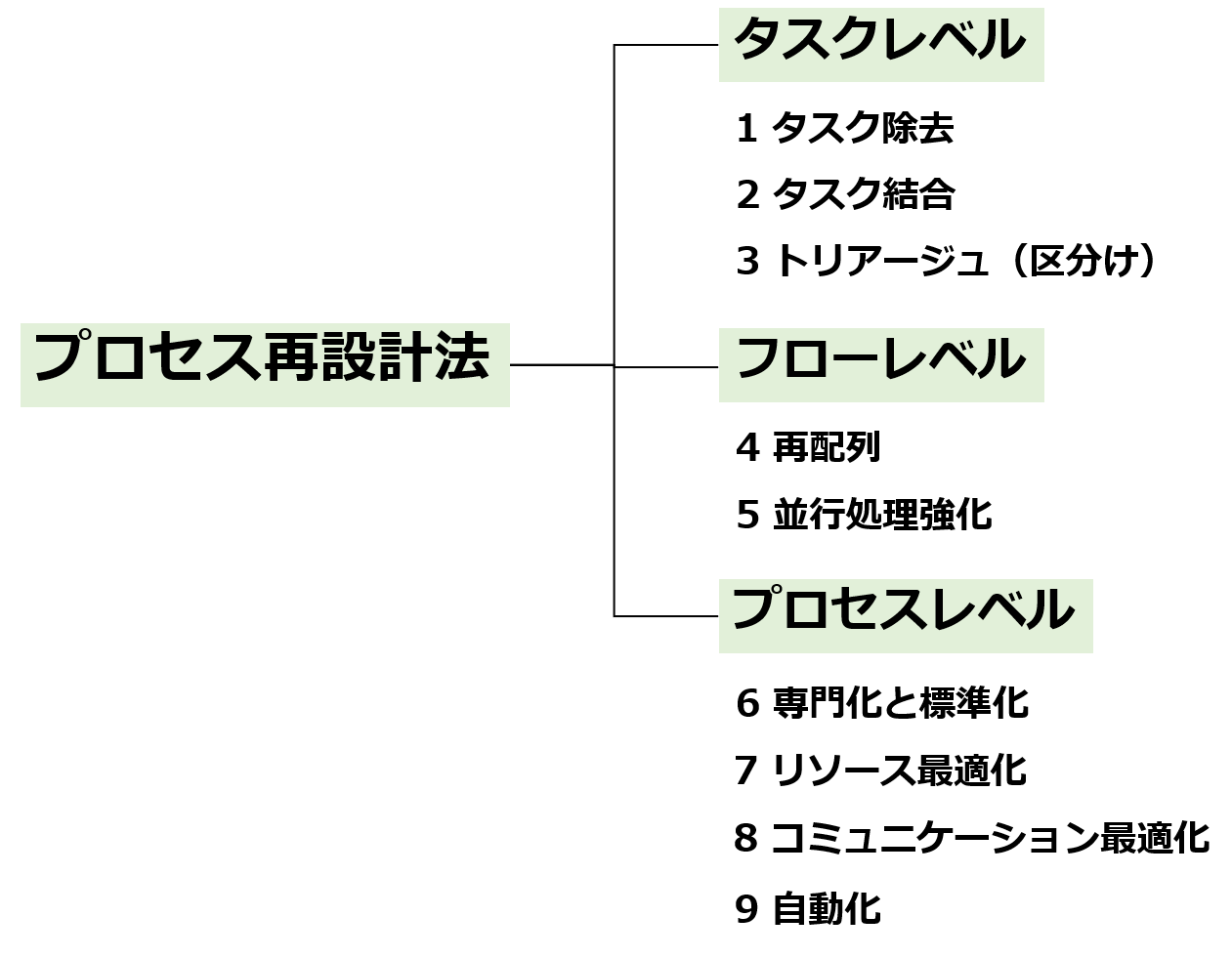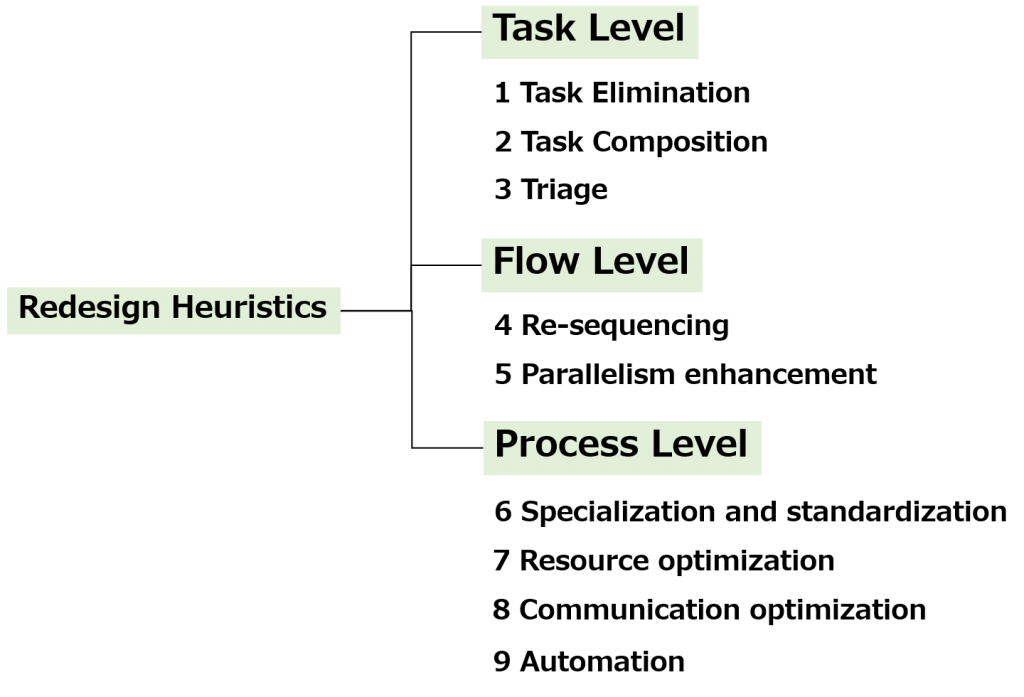Heuristic Process Redesign – Basic 9 Approaches
English follows Japanese. Before proofread.
プロセスマイニングやタスクマイニングで、分析対象プロセスにおける非効率なプロセスやボトルネックを発見できた。しかし、そこで完了ではありませんよね。
言うまでもなく、プロセスマイニングやタスクマイニングは、データ分析を通じて問題点を容易にあぶりだすことができますが、「こうすれば問題を解決できる」という改善施策を教えてくれるわけではありません。(将来的には、プロセスマイニングツールに高度なAI機能が実装され、改善施策のヒントを示唆してくれる、という可能性はあります)
したがって、プロセスに関わる問題点を発見できたら、プロセスマイニング、タスクマイニングの出番はいったん終了となります。
問題点発見後に活躍するのは、リーン・シックスシグマを始めとする問題解決手法です。問題解決手法では、5WHYや要因分析(魚の骨分析)などの各種フレームワークを用いて、問題の背景にある根本原因を探るとともに、具体的な改善施策を立案、実行します。
当記事では、具体的な改善施策を検討するために参考になる9つの再設計手法をご紹介します。これら再設計手法はBPM(Business Process Management)において体系化されたものです。過去に数多く実施されたプロセス改善プロジェクトを通じて経験則的に編み出された実践的な手法です。
なお、実はプロセス再設計の経験則は30個近くあります。うち、今回ご紹介する9つの手法は最も一般的で改善効果が出やすいものです。
なお、9つのプロセス再設計法は、大きくは3つのレベル(タスクレベル、フローレベル)、プロセスレベル)に分類することができます。各手法の解説は3つのレベルごとに行っていきます。
タスクレベル
プロセスを構成する個々のタスク(アクティビティ)についてなんらかの変更行うものです。
1 タスク除去
所要時間が長い要因となっているタスクについて、そもそもそのタスクはやる価値があるのか、いっそなくしてしまう、あるいは回数を減らすものです。
例えば、承認タスクが3段階あり、形骸化している場合、1段階減らして2段階のタスクにする。また、検品プロセスで、全品に対して検査を行うのではなく、無作為抽出した一部の製品のみの検査を行う統計的方法に変えることで、検査タスク件数を数分の一に減らす、といったことが考えられます。
2 タスク結合
タスクが細かく細分化されていたり、複数の部署間でタスクの受け渡しが発生していると、所要時間が長くなりがちです。したがって、複数に分かれているタスクを1つのタスクで統合してしまう、他部署にタスクを渡さないで自部署でまとめてタスクをやってしまう、といったタスク統合が有効な場合があります。(逆に、複数の作業が一つのタスクにまとまっていることで非効率になることもあります。その場合は、タスクを分解することが有効な場合もあります)
3 トリアージュ(区分け)
あるプロセスに、条件分岐でサブプロセスを走らせたほうが所要時間が短縮できる場合があります。たとえば、調達プロセスで購買申請受付に続くタスクとして、金額が1千万円以上、以下で異なるプロセスを走らせるといった方法です。
逆に、サブプロセスが多すぎることによって複雑化している場合には、いくつかのサブプロセスを統合することも検討すべきでしょう。
フローレベル
タスク単体ではなく、タスクとタスクの順序についての改善手法です。
4 再配列
タスクの流れを見直し、最も効率的で、また作業量が最小となるような順番に組みなおすのが再配列です。
例えば、調達プロセスにおいて、AとBの2つの承認タスクが含まれている場合に、Aのタスクでは平均1%が差戻しとなり、Bのタスクでは10%が差し戻しになるとします。この場合、より多くの差戻しが発生するBのタスクをAのタスクの前にもってきたほうが、Aの承認件数が相対的に減少し、全体としてはより効率的、作業量を減らすことが可能となります。
5 並行処理強化
あるプロセスにおいて、前のタスクが終了して初めて次のタスクが始まるという逐次処理が行われている場合に、逐次ではなく、並行して複数のタスクを処理するプロセスに変更すれば、プロセス全体の所要時間の短縮が見込めます。
逐次処理タスクを並行処理に変更することはしばしばスループット短縮に大きな効果があります。
プロセスレベル
個々のタスク、タスク間の順序以外に、別の視点も踏まえた改善を行うものです。
6 専門化と標準化
専門化は、あるプロセスを複数のサブプロセスに分けて、それぞれに担当者を割り当てて専門性を高めてもらうことで効率化や顧客満足向上などを目指すものです、例えば、VIPと一般客に分けて、特にVIPに対してはスピーディで丁寧なサービスプロセスを提供するようなものです。
逆に、標準化は、製品別などで分かれているために同一の業務なのに複数のプロセスが存在している場合に一本化を図るものです。
7 リソース最適化
同じ業務プロセスを複数の担当者で遂行している場合に、特定の担当者に業務量が集中し、他の担当者が遊んでしまっているといった状況、あるいは、業務量に対して担当者が少ないために待ち業務が積みあがってボトルネックになっている、といった問題点に対しては、担当者の割り当てを工夫する、担当者のシフトを見直すなどの「リソース最適化」が必要となります。
8 コミュニケーション最適化
プロセスの流れが、電話やFAX、メールなど、なんらかのコミュニケーションをきっかけに駆動する場合、例えばコミュニケーションを受けるタイミング、処理するタイミングなどを変更することで、効率化や顧客満足が向上できる場合があります。
9 自動化
明確な一定の手順が存在する定型業務の場合はRPAによる自動化が有効となるでしょう。また、インプットされた情報に基づいて自動判定するようなアプリケーションを開発するなど、自動化の選択肢も複数あります。

自社のプロセス改善・改革プロジェクト、あるいはDX(Digital Transformation)推進プロジェクトにおいて、個々の問題・課題に対する解決策を導く場合に、まずはこれら9つの経験則が適用できないか検討してみましょう。
なお、冒頭で述べたように、プロセス再設計の経験則は、『Fundamentals of Business Process Management』では29個紹介されています。
また、同書に準拠したMOOC(eラーニング)では、今回ご紹介した9つのプロセス再設計方法について詳しく解説されていますのでぜひご覧になってみてください。
(Resources)
Heuristic Process Redesign – Basic 9 Approaches
Thanks to process mining and task mining, you are able to find inefficient processes and bottlenecks in the process. But that’s not where it’s done, is it?
Needless to say, process mining and task mining make it easy to uncover problems through data analysis, but they don’t tell you how you can solve problems. (It’s plausible that in the future, advanced AI capabilities will be added in process mining tools to hint at ways to improve them.
Therefore, once a problem related to the process has been found, the process mining and task mining are no longer needed for the time being.
What comes into play after finding a problem is problem-solving techniques, including Lean Six Sigma. In those problem-solving methods, you can use various frameworks such as 5WHY and factor analysis (fish bone analysis) to find the root cause behind the problem, and then plan and implement specific improvement measures.
This article introduces nine redesign methods that can be used as a reference to consider specific improvement measures. These redesign methods are systematized in BPM (Business Process Management). This is a practical method that has been developed empirically through numerous process improvement projects that have been implemented in the past.
In fact, there are nearly 30 rules of thumb for process redesign. Of these, the nine methods I’m going to share with you are the most common and most likely to produce improvements.
The nine process redesign methods can be broadly categorized into three levels (task level, flow level) and process level). Each method will be explained at each of the three levels.
TASK Level
This is a change of any kind to the individual tasks (activities) that make up the process.
1 Task Elimination
For those tasks that are taking a long time, it’s important to ask yourself if the task is worth doing in the first place, eliminate it, or reduce the number of times you do it.
For example, if there are three levels of approval tasks and they are formidable, reduce them by one level to two. In the inspection process, the number of inspection tasks could be reduced by a fraction of a percent by changing to a statistical method that only inspects a small portion of randomly selected products, rather than inspecting all products.
2 Task composition (decomposition)
When tasks are subdivided into smaller chunks, or when tasks are passed between multiple departments, the time required is often longer. Therefore, it may be effective to consolidate multiple tasks into a single task, or to consolidate tasks in your own department without passing them on to other departments. (Conversely, multiple tasks can become inefficient when they are combined into a single task. (In that case, it may be useful to break down the task).
3 Triage
In some cases, running sub-processes in a conditional branch may reduce the time required for a process. For example, in the procurement process, a task following the receipt of a purchase application would be to run different processes for amounts over 10 million and below.
Conversely, if the complexity is compounded by too many sub-processes, you may want to consider consolidating some of them.
FLOW level
It’s an improvement method for the order of tasks, not just a single task.
4 Re-sequencing
Re-sequencing is about reviewing the flow of tasks and rearranging them in the order that is most efficient and requires the least amount of work.
For example, if the procurement process includes two approval tasks, A and B, then on average 1% of the A task will be set back and 10% of the B task will be set back. In this case, bringing task B, which has more regressions, before task A will result in a relative decrease in the number of approvals for A, which will be more efficient and reduce the workload overall.
5 Parallelism enhancement
In some processes, where sequential processing is used, where the next task starts only after the previous task is completed, if the process is changed to one where multiple tasks are processed in parallel instead of sequentially, it is expected to reduce the time required for the entire process.
Changing sequential processing tasks to concurrent processing often has a significant effect on throughput reduction.
PROCESS level
It is an improvement based on another perspective besides the individual tasks and the order between them.
6 Specialization and standardization
Specialization aims to improve efficiency and customer satisfaction by dividing a process into multiple processes and assigning a person in charge to each sub-process to increase the expertise. For example, it is possible to divide a process into VIPs and general customers and provide a speedy and courteous service process especially for VIPs.
On the contrary, standardization is an attempt to unify multiple processes in the case of the same business because they are separated by product, etc.
7 Resource Optimization
When multiple people are running the same business process, the amount of work is concentrated on a particular person while other people are playing around, or when there is a bottleneck due to the lack of people in charge of the same amount of work, it is necessary to “optimize resources” by devising the assignment of people in charge or reviewing the shifts of people in charge.
8 Communication Optimization
If the process flow is driven by some kind of communication, such as a phone call, fax, or email, you may be able to improve efficiency and customer satisfaction by changing the timing of receiving or processing communication, for example.
9 Automation
For routine tasks where there is a clear set of procedures, automation with RPA can be effective. There are also multiple options for automation, such as developing an application that makes automatic decisions based on the input information.
Let’s first consider whether these nine rules of thumb can be applied to your own process improvement/innovation project or DX (Digital Transformation) promotion project when guiding a solution to an individual problem or issue.
As mentioned at the beginning, 29 rules of thumb for process redesign are presented in the “Fundamentals of Business Process Management”.
In addition, please take a look at the MOOCs (e-learning), which is based on the book, for detailed explanations of the nine process redesign methods introduced in the book.
(Resources)


